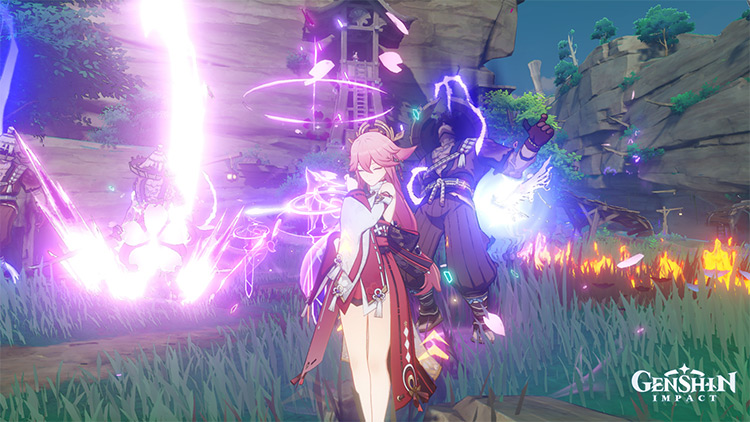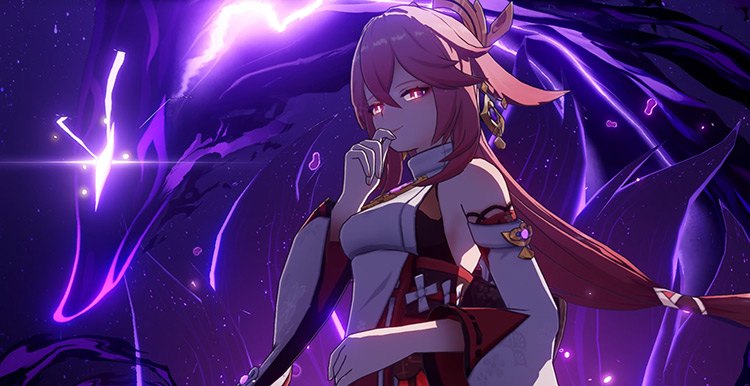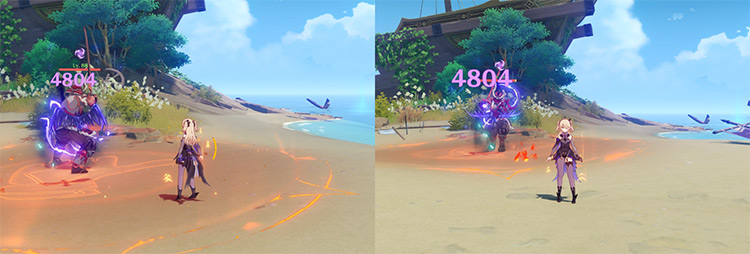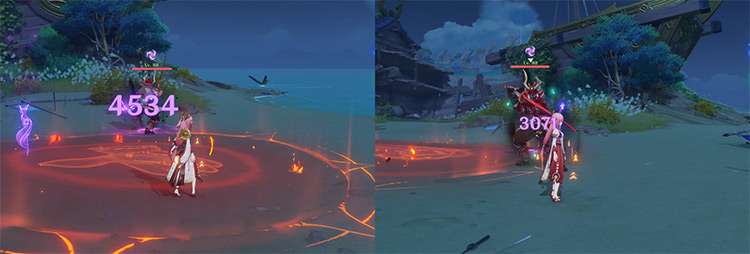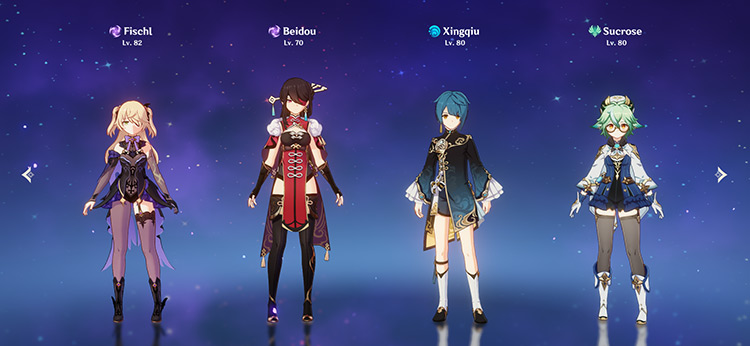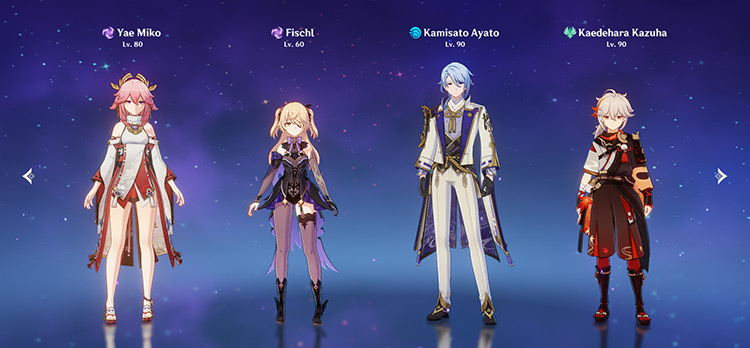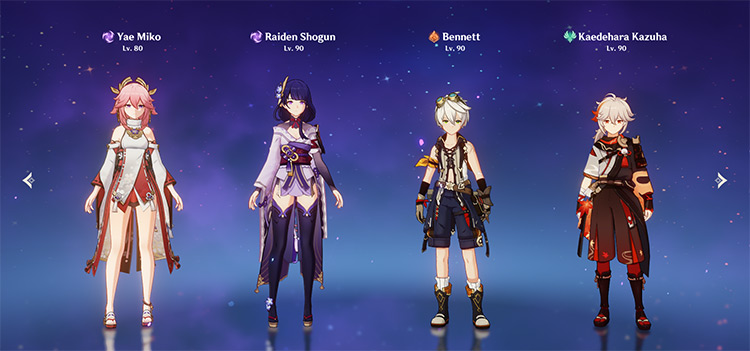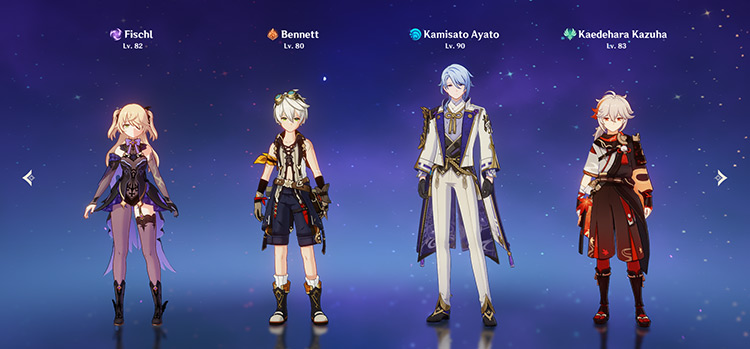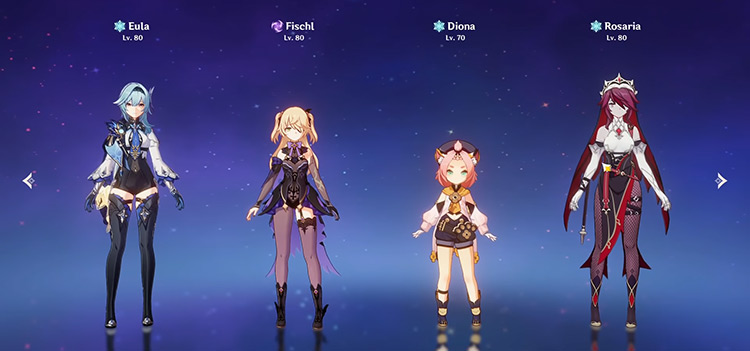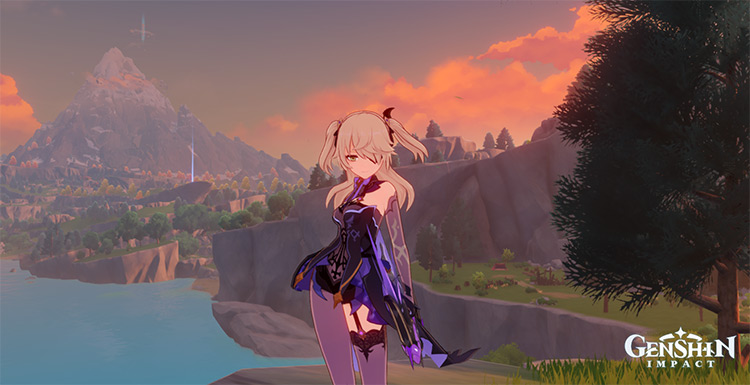Still, Fischl is better than Yae. Aside from damage, this is because Fischl has the extra utility as a battery – and she has much smoother gameplay. As a battery, Fischl generates a lot of energy particles that help charge teammates’ bursts, especially Electro units. In contrast, Yae has zero utility. Her entire kit is dedicated to only dealing damage. However, most of her issues come from her field time and gameplay. Yae consumes a lot of field time despite being an off-field DPS. Her setup includes casting her skills thrice – using Yae’s burst also requires her to re-cast all her skills again. Each skill cast locks her into an animation where she can’t move or dodge. This leaves her vulnerable to taking damage and getting interrupted. Because of these issues, Yae can feel clunky to play. To better explain, let’s compare their character values and performance in the two game modes of Genshin Impact: Overworld (Exploration & Co-op) and Spiral Abyss (Meta). Note: All comparisons made are between a C0 Yae and C6 Fischl.
In The Overworld
Exploration (Single-Player)
Yae and Fischl are equally great in single-player. They deal strong and low-effort damage. Since Oz and Yae’s totems automatically attack opponents, they do most of the DPS for you! This is a great kit feature that basically lets you go AFK mid-battle.
Co-op (Multiplayer)
Generally, Yae and Fischl perform similarly in Co-op. Most of Fischl’s value comes from being able to deal strong off-field damage through Oz. She loses a lot of this value when she’s on-field during Co-op. Oz will still deal good damage, but their total DPS is much lower than an actual on-field DPS. While the same applies to Yae, she is a catalyst user – all her attacks deal Electro damage. So her normal and charged attacks benefit from her Electro damage bonus stats. However, Yae is especially unfavorable if another Co-op teammate is also playing her. Only 3 Sesshou Sakura can exist at once – this applies even in Co-op. If more than one player is using Yae, casting her skill destroys and replaces the oldest totem regardless of its owner. Additionally, casting her burst will destroy all Sesshou Sakura on-field regardless of its owner. Because of this, multiple Yae’s in Co-op will effectively deal the same damage as 1 Yae.
Spiral Abyss (Meta)
Gameplay Tech
Yae and Fischl differ in how their abilities scale off stats. Fischl’s Oz can snapshot, while Yae’s totems are dynamic. This refers to how certain abilities can snapshot the stats active when they are cast. Snapshotting applies to Fischl’s Oz and any outgoing damage related to Oz. A demonstration can be seen in the photos above. Bennett’s burst (the red circle) buffs Fischl’s ATK – this can be seen in the first photo. It also shows Oz’s damage with this ATK buff. In the second photo, Fischl leaves Bennett’s burst and loses the ATK buff. Because Oz can snapshot, he deals the same damage. Fischl’s 2nd passive and C6 also benefit from this since their damage scales off Oz’s stats. So, Oz snapshotting buffs will also buff their extra damage. In most cases, being able to snapshot is really good – especially in most Fischl teams. Snapshotting lets you stack buffs before casting Oz. This lets him deal buffed damage for his entire duration. However, this also means that rotations are slightly stricter. You would need to cast buffs before Fischl’s skill for Oz to benefit from them. This is the opposite of snapshot. For Yae, this means that her Sesshou Sakura will scale off her active stats – they can’t snapshot. If Yae gains or loses stats, this will reflect in the totems’ damage. This is demonstrated by the photos below. In the first photo, Yae gains an ATK buff from Bennett’s burst – so her totems also gain the ATK buff. Once she leaves the burst or after it expires, she loses the buff. Because her totems are dynamic, their damage also decreases. You can see this damage loss in the second photo. The same mechanic applies when Yae leaves the field. For instance, Bennett’s burst only buffs the active character within its circle. So, Yae also loses the buff when she goes off-field. In some cases, dynamic abilities are beneficial. It allows for more lenient rotations. Unlike Fischl, you can cast Yae’s skill first and then apply the buffs after. But this also means that Yae loses DPS when the buffs end. Additionally, Yae won’t benefit from any on-field buffs while off-field – which is often because she’s an off-field DPS.
Best Team Compositions
Yae’s and Fischl’s kits are very similar. They can replace each other in most of their top teams. Plus, Fischl’s extra utility as a battery makes her a great teammate for Yae. Here’s a TL;DR on who performs better in those teams and why. Taser teams are generally composed of:
2 Electro units 1 Hydro unit 1 Anemo unit
The most common variation of Taser is Beidou Taser. This team includes Beidou, Fischl, Xingqiu, and Sucrose. This variant is especially good against 2 or more targets. In this team, Fischl serves as Beidou’s battery. Oz generates a lot of energy particles that greatly help charge or battery Beidou’s burst. Additionally, she deals strong off-field DPS through Oz, her 2nd passive, and her C6. Yae’s energy generation is much weaker than Fischl’s. This means that she can’t replace Fischl as Beidou’s battery. Instead, Yae can replace Beidou. Yae Taser teams include:
Yae Fischl/Raiden 1 Hydro unit 1 Anemo unit
This team outperforms Sucrose Taser in single-target. As a battery, Fischl helps charge Yae’s burst while dealing high personal damage herself. This team is composed of:
Raiden 1 Electro unit Bennett Kazuha
This is a team where Raiden spends the most field time — particularly during her burst. Both Yae and Fischl are great units for this team. They deal strong off-field DPS, and their damage outputs are very similar. Here’s a summary of their main differences in this slot. Soup teams are composed of:
1 Electro unit 1 Pyro unit 1 Hydro unit 1 Anemo unit
Fischl performs significantly better than Yae in this team. Multiple elemental reactions are always being triggered, so her 2nd passive is also constantly being procced. This passive also lets Fischl apply more Electro than Yae. More Electro application lets the team trigger more elemental reactions – thus dealing more damage. Additionally, energy is a common problem in Soup teams. Characters gain a lot more energy when they collect energy particles of the same element. Since each unit has a different element, they can have trouble charging their bursts. Fischl being able to generate a lot of energy particles – although it’s mainly Electro particles – can help charge the team’s bursts. The party members of Physical teams vary on who’s the Physical DPS. However, this team will always use at least 1 Electro unit – Yae and Fischl are both great options for this slot. They deal strong off-field damage and apply consistent Electro application. This lets them continuously proc superconduct reactions. Superconduct is an AOE elemental reaction between Electro and Cryo. It shreds opponents’ Physical resistance by 40% for 12s. This directly boosts the Physical DPS unit’s damage. In this team, their damage and Electro application are very similar. So their only difference is in gameplay. Since Fischl consumes less field time than Yae, the Physical DPS can perform more attacks on-field. Additionally, her strong energy particle generation can help charge the team’s bursts.
Who Should You Build?
Fischl is always worth building. She can slot into most teams – only freeze teams can’t use Fischl as a party member. In any team, she’s a solid battery and strong off-field DPS. Fischl’s versatility as a unit definitely pulls her ahead of Yae. Plus, even if you pull and build Yae, Fischl is still one of her best teammates!
